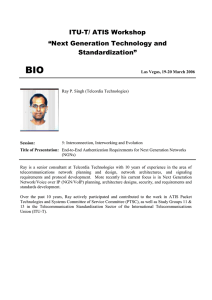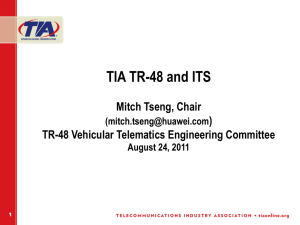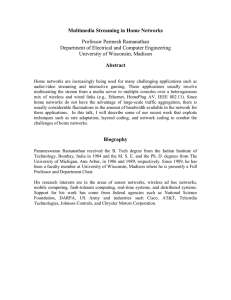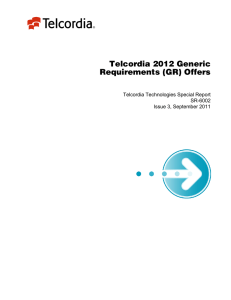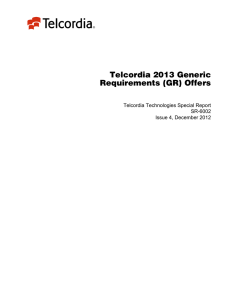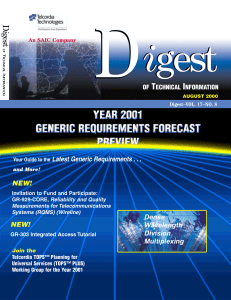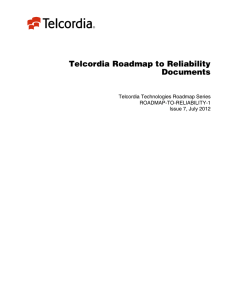SI05-02 - Semtech
advertisement
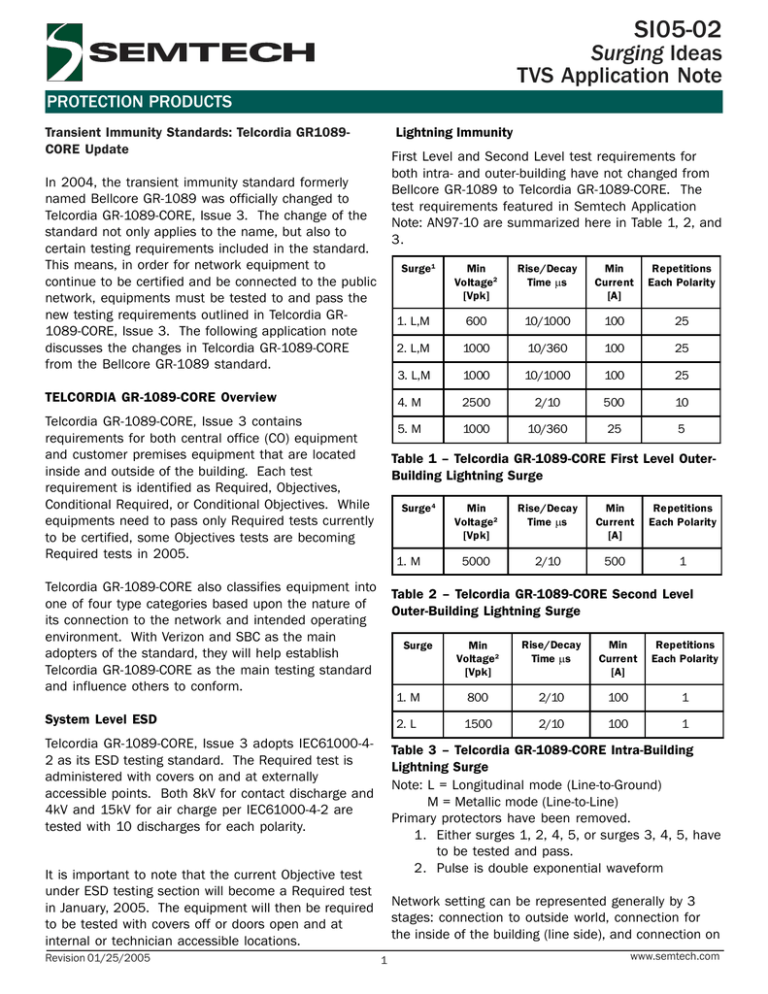
SI05-02 Surging Ideas TVS Application Note PROTECTION PRODUCTS Transient Immunity Standards: Telcordia GR1089CORE Update Lightning Immunity First Level and Second Level test requirements for both intra- and outer-building have not changed from Bellcore GR-1089 to Telcordia GR-1089-CORE. The test requirements featured in Semtech Application Note: AN97-10 are summarized here in Table 1, 2, and 3. In 2004, the transient immunity standard formerly named Bellcore GR-1089 was officially changed to Telcordia GR-1089-CORE, Issue 3. The change of the standard not only applies to the name, but also to certain testing requirements included in the standard. This means, in order for network equipment to continue to be certified and be connected to the public network, equipments must be tested to and pass the new testing requirements outlined in Telcordia GR1089-CORE, Issue 3. The following application note discusses the changes in Telcordia GR-1089-CORE from the Bellcore GR-1089 standard. Surge1 TELCORDIA GR-1089-CORE Overview Telcordia GR-1089-CORE, Issue 3 contains requirements for both central office (CO) equipment and customer premises equipment that are located inside and outside of the building. Each test requirement is identified as Required, Objectives, Conditional Required, or Conditional Objectives. While equipments need to pass only Required tests currently to be certified, some Objectives tests are becoming Required tests in 2005. Rise/Decay Time µs Min Current [A] Repetitions Each Polarity 1. L,M 600 10/1000 100 25 2. L,M 1000 10/360 100 25 3. L,M 1000 10/1000 100 25 4. M 2500 2/10 500 10 5. M 1000 10/360 25 5 Table 1 – Telcordia GR-1089-CORE First Level OuterBuilding Lightning Surge Surge 4 1. M Telcordia GR-1089-CORE also classifies equipment into one of four type categories based upon the nature of its connection to the network and intended operating environment. With Verizon and SBC as the main adopters of the standard, they will help establish Telcordia GR-1089-CORE as the main testing standard and influence others to conform. Min Voltage2 [Vpk] Rise/Decay Time µs Min Current [A] Repetitions Each Polarity 5000 2/10 500 1 Table 2 – Telcordia GR-1089-CORE Second Level Outer-Building Lightning Surge Min Voltage2 [Vpk] Rise/Decay Time µs Min Current [A] Repetitions Each Polarity 1. M 800 2/10 100 1 2. L 1500 2/10 100 1 Surge System Level ESD Telcordia GR-1089-CORE, Issue 3 adopts IEC61000-42 as its ESD testing standard. The Required test is administered with covers on and at externally accessible points. Both 8kV for contact discharge and 4kV and 15kV for air charge per IEC61000-4-2 are tested with 10 discharges for each polarity. Table 3 – Telcordia GR-1089-CORE Intra-Building Lightning Surge Note: L = Longitudinal mode (Line-to-Ground) M = Metallic mode (Line-to-Line) Primary protectors have been removed. 1. Either surges 1, 2, 4, 5, or surges 3, 4, 5, have to be tested and pass. 2. Pulse is double exponential waveform It is important to note that the current Objective test under ESD testing section will become a Required test in January, 2005. The equipment will then be required to be tested with covers off or doors open and at internal or technician accessible locations. Revision 01/25/2005 Min Voltage2 [Vpk] Network setting can be represented generally by 3 stages: connection to outside world, connection for the inside of the building (line side), and connection on 1 www.semtech.com SI05-02 Surging Ideas TVS Application Note PROTECTION PRODUCTS IC board (board side). Protection used for connection to the outside world, such as gas tube and carbon block, is considered to be primary protection. These are the devices that are required to be removed for all tests. The passing requirements for First Level Lightning Tests and Second Level Lightning Tests, now including Reduced Level Test, is the same as Bellcore GR-1089. In other words, First Level Test verifies the equipment’s ability to continue to function from a moderate threat situation while Second Level Test checks for the equipment’s resistance to first, fragmentation, and electrical safety hazards from severe threats. Protection used for lines inside of the building and on IC boards, are both considered to be secondary protection. Various protection options, such as thyristors and TVS diodes, are available to serve as secondary protection. While thyristors generally have maximum clamping voltages rated at a few hundred volts, TVS diodes have maximum clamping voltages in the range of tens of volts. CONCLUSION With the new Telcordia GR-1089-CORE, issue 3 replacing the Bellcore GR1089, it is important for network equipment makers to be aware of the changes. It is necessary to consider an adequate protection scheme early and choose appropriate secondary protection to increase the equipment’s chance of passing the test standard. With testing success experienced at independent certification labs and with high protection performance, Semtech offers superior protection devices that will help equipment meet the Telcordia GR-1089-CORE, Issue 3 requirements. It is important to note that when a secondary protection device is used in the equipment, these lightning tests need to be repeated again with the secondary protection device removed. Specifically, Telcordia GR-1089-CORE requires a Reduced Level Test to be performed at 0.707 times the maximum clamping voltage rated on the datasheet of the secondary protection device with both the primary and secondary protection device removed. However, with current lightning testing equipment’s capability limited to a minimum of 50V output voltage, only network equipment using secondary protection with maximum clamping voltage rated higher than 50V are subjected to the Reduced Level Test. In other words, network equipments using TVS diodes with low maximum clamping voltages as secondary protection products do not need to be tested at the Reduced Level Test. For the purpose of the Reduced Level Test, Semtech TVS protection products offer an optimal solution. Semtech offers secondary protection products for both the line and the IC side, such as LC01-6 and SRV05-4. Since all Semtech’s protection products for network equipments have maximum clamping voltages lower than 30V, by using Semtech’s protection products, equipments do not need to be tested by the Reduced Level Test. Furthermore, because using thyristors means the equipments will be subjected to two sets of tests, using TVS diodes also means the equipments will only need to go through one round of testing, and therefore, saving certification process time. 2 www.semtech.com
